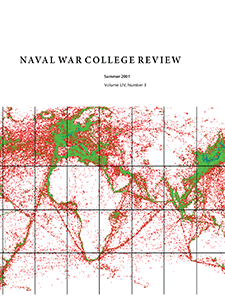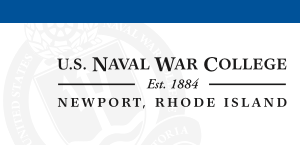Naval War College Review
Volume 54, Number 3 (2001) Summer
n one of his best-known presentations, “The Future Security Environment: Challenges in Maritime Security,” the President of the Naval War College, Vice Admiral Arthur K. Cebrowski, offers several ways of conceptualizing the “domain” in which the U.S. Navy operates. “Of them, a less traditional, but compelling, approach is electronic. If one plots on a blank sheet of paper the location of radio emissions related to commerce, the result is a map of the world, with very prominent zones coinciding with conflict fault-lines. An analysis of the world’s finely tuned network. . . .” Our cover, adapted from the briefing graphic, produced by the College’s Graphics Department, to which the Admiral spoke) depicts that coherent pattern. . . . In this issue, Dr. Daniel Gouré of the Lexington Institute challenges the necessity for forward deployment and the capacity of the U.S. Navy to maintain it. Professor James F. Miskel, of the Naval War College faculty, takes the opposite view. . . . An early iteration of the Admiral’s presentation was reprinted as our Summer 1999 “President’s Notes.”
Full Issue
Summer 2001 Review
The U.S. Naval War College
From the Editors
From the Editors
The U.S. Naval War College Press
President's Forum
President’s Forum
Arthur K. Cebrowski
Articles
The Tyranny of Forward Presence
Daniel Gouré
“Being There” Matters—But Where?
James F. Miskel
India and Pakistan
Paul D. Taylor
“Security Is Like Oxygen”
Seth Appiah-Mensah
Future Carrier Aviation Options
David J. Jordan
Transforming the U.S. Armed Forces
Thomas G. Mahnken
New Insights from Old Books
Jon Sumida
The Coast Guard and Navy
Colin S. Gray
Book Reviews
Book Reviews
The U.S. Naval War College
Planning the Unthinkable: How New Powers Will Use Nuclear, Biological,and Chemical Weapons,
K. A. Beyoghlow
Chemical-Biological Defense: U.S. Military Policies andDecisions in the Gulf War,
Pietro D. Marghella
The Changing Role of Information in Warfare,
Eric J. Dahl
Identifying Potential Ethnic Conflict,
Pauletta Otis
Japan’s Navy: Politics and Paradox, 1971–2000
Robert Morabito.
Flying Black Ponies,
William M. Calhoun
How Effective Is Strategic Bombing?Lessons Learned from World War II to Kosovo,
Phillip S. Meilinger
American Airpower Strategy in Korea, 1950–1953
Wilfred F. Brown
Decoding History: The Battle of the Atlantic and Ultra,
Christopher Bell
Dog Boats at War: Royal Navy D Class MTBs and MGBs, 1939–1945,
Carl Otis Schuster
The Legacy of the White Oak Laboratory,
Frank C. Mahncke
Additional Writings
Set and Drift: Doctrine MattersWhy the Japanese Lost at Midway
Jonathan B. Parshall, David D. Dickson, and Anthony P. Tully
Set and Drift: The Perils of Paperless
Patrick J. Geary
In My View
Stanley Weintraub and Dallas Woodbury Isom
Review Essay: Where Will Presidential Autocracy Take Russia?
Sergei Khrushchev


